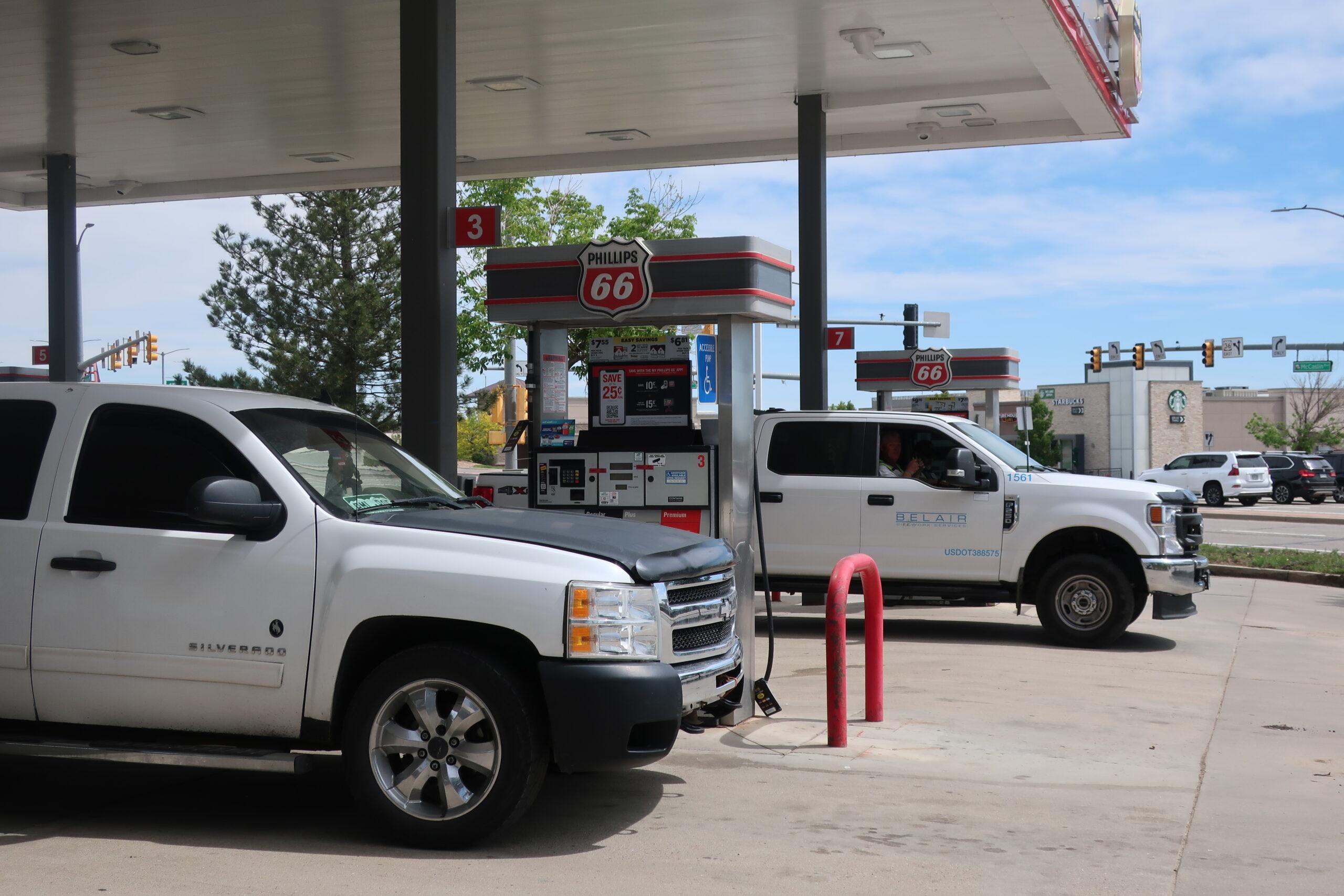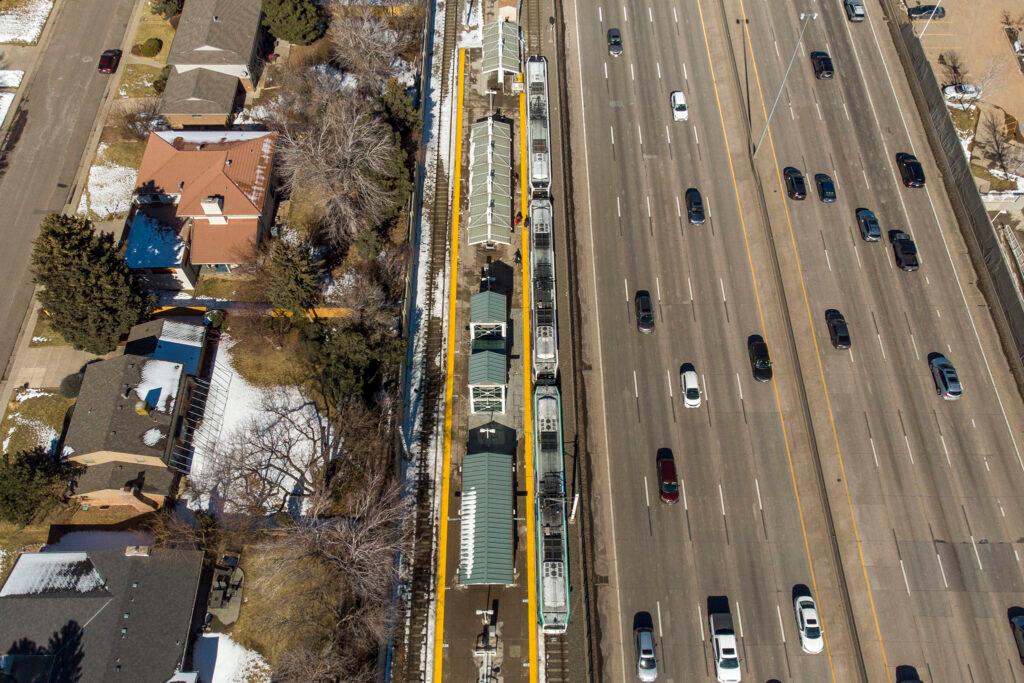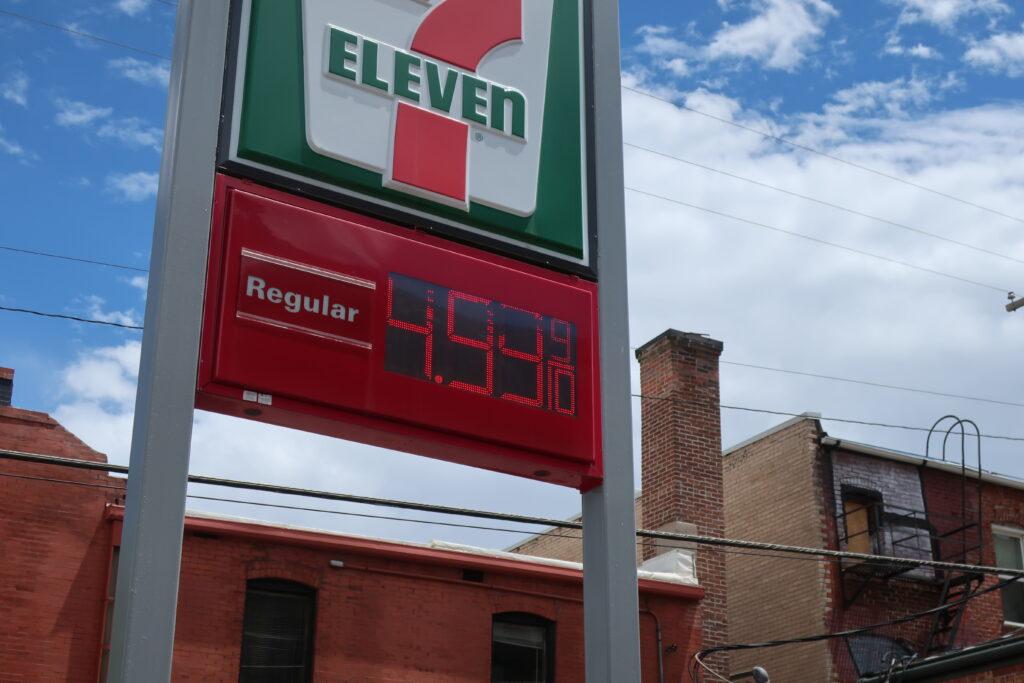
Andy Burns grimaced as he watched the gas pump filling his GMC truck tick past $80, then $90, then $100.
“I knew this was gonna be expensive, but wow” said Burns, keeping one hand on the pump handle as he watched the numbers on a screen at a Phillips 66 in Superior.
Burns was on his way out of town for a road trip with his son. The Boulder resident planned on surprising his mother in Michigan — a long-anticipated vacation that made the fuel cost worth it, he said.
“We’re probably going to cut a lot of our lodging to make up for the gas prices,” Burns said. “Not fun, but you gotta do what you gotta do.”
Coloradans are coming face-to-face with eye-popping price tags as they hit the road this summer. On Monday, the state’s average price for a gallon of unleaded reached $4.62, which is the highest it has ever recorded.
The number is even higher in mountain communities, with places like Aspen and Telluride seeing average prices well over $5 a gallon. The jump represents a 40 percent increase from this time last year.
Prices rose $.60 per gallon for regular unleaded in the past month alone as the summer travel season kicked off, according to AAA Colorado, which tracks fuel costs across the state. Diesel prices saw a softer increase to $5.39, a small jump of 2 cents from a month ago.
As a result, roughly 67 percent of drivers have started to drive less, according to a AAA survey of Colorado residents.
Pain at the pump has forced some people to readjust their vacation plans, rethink their work commutes and cut back on the amount they’re saving each month.
Fred Collier, a Poudre Canyon resident, drives his ‘99 Toyota Camry to Fort Collins three nights a week to deliver pizzas.
He used to make his weekend’s gas money, plus some, after his first night of working. Now it’s taking closer to two days to recoup his fuel costs. Collier recently crunched the numbers and found out he likely won’t turn a profit if prices for unleaded continue to approach $5 a gallon.
“It’s a shame because I genuinely enjoy my job,” he said. “But if I’m burning it all up in my car, it’s not really worth it.”
Why prices are rising
Fuel prices began their upward climb in mid-March, when Russia’s invasion of Ukraine sent global oil markets into a panic.
Shortage fears stemming from the conflict pushed the cost of a single barrel to around $120 — the highest amount in almost a decade. Crude oil prices are the single largest contributor to regular gas prices, according to the Energy Information Administration.
Meanwhile, travel demand has bounced back from pandemic lows, and that rebound has outpaced oil producers’ attempts to increase supply.
The Colorado Department of Transportation and Denver International Airport both reported near pre-pandemic passenger numbers on roads and airplanes over the recent Memorial Day holiday, signaling the start of a busy summer.
“Americans are able to travel again more freely than they have in the past two years and they’re sort of cashing in on that,” said Skyler McKinley, a spokesman for AAA Colorado. “Now they’re having to make other economic choices like eating out less in order to be able to travel.”
The supply-demand imbalance of fuel has created a worst-case scenario for budget-conscious drivers, McKinley said.
“We’re talking about noticeable money now for most people,” McKinley said. “What remains to be seen is how much the high prices will soften demand to the extent that prices stabilize or even come down.”
Some observers have also pointed fingers at oil companies for artificially inflating prices to satisfy investors, even as the price of crude oil has fluctuated. Democratic Rep. Diana DeGette and other members of the House Energy and Commerce Committee questioned oil executives during a contentious hearing on the issue in April.
Executives denied any wrongdoing and blamed market forces for the bulk of the increases.
“I want to be absolutely clear: We do not control the market price of crude oil or natural gas, nor of refined products like gasoline and diesel fuel,” said Michael Wirth, Chevron’s CEO, during the hearing.
“We have no tolerance for price gouging,” he said.

Some look to public transit, other transportation options
As prices began to rise this spring, Camilla Cluett started to look for alternatives to commuting across Denver by car every day.
She initially tried going out of her way to fill up at cheaper stations like Costco, but that drive took an extra 20 minutes, burning crucial fuel and time. She now tries to take an RTD train to her job at Meow Wolf in the city’s Sunnyside neighborhood at least three times a week.
“It’s very convenient,” she said. “But if I’m working the closing shift, I still have to drive because the train doesn’t run late enough.”
Public transit ridership in the Denver area has seen a slight increase in ridership over recent months, but it remains below pre-pandemic levels. Metro area residents took 4.8 million trips via bus or train in March — a 42 percent jump over the same time in 2021, according to RTD’s latest ridership figures.
However, it’s difficult to directly connect higher ridership numbers to higher gas prices, said Christina Zazueta, the agency’s community engagement manager.
“There are so many factors affecting ridership that it is difficult to arrive at a direct correlation,” Zazueta said. “It is more complicated than gas prices. Factors affecting the answer include seasonality, weather, service levels and the opening of new lines, for example.”
There is likely some relation, she added. When gas prices spiked in 2008, ridership also saw a jump.
“But it was not as dramatic as one might expect,” she said. “The idea that gas prices and ridership are highly interrelated was gutted in 2014, when gas prices fell but ridership stayed about the same.”
Colorado’s electric car and plug-in hybrid sales are also seeing a steady increase, signaling that buyers have a stronger appetite for EVs.
Those types of cars made up 8.6 percent of new vehicle registrations in the first quarter of 2022—up from 5.6 percent the year before, according to the Colorado Automobile Dealers Association.
Still, new EVs remain too expensive for many buyers. Supply in the new vehicle market also remains tight due to chip shortages and delivery delays.
Cluett said she thought about looking into EV options, but her budget ultimately won’t allow for it this year, she said.
“I am not in a financial place to be buying a new car,” she said. “And if I had the disposable income, I would want to do lots of research first, so I’m kind of stuck.”

Is relief in sight?
The short answer is likely no, given how high travel demand is.
Prices in Colorado typically spike around Memorial Day and then gradually increase through Labor Day, said McKinley.
“The prices we’re paying now are very much the summer floor,” he said. “Now is a great time to begin thinking strategically about how to save if you’re worried, knowing that there are high, high prices yet ahead of us.”
It’s still too early to tell how high things could get, he noted. Factors like a busy hurricane season in the Gulf of Mexico could rattle oil markets and send prices climbing faster.
“That could affect refining and how we move gas around the country,” McKinley said. “It’s kind of a scary open question right now.”
The rise hasn’t had a huge impact on consumer spending in Colorado yet. Retail sales have stayed relatively flat despite rising gas prices.
Personal savings are another story. After saving record amounts of money during the pandemic, many workers have begun to pull back on their monthly contributions to their piggy banks. The amount of money the average American was saving each month dipped to 4.4 percent of their income in April, according to the Bureau of Economic Analysis.
That’s down from a high of 8.7 percent last December.
“That seems to be really where people are getting hit the hardest right now,” said Brian Lewandowski, an economist with CU Boulder’s Leeds School of Business.
Juan Carillo, a beverage delivery driver who lives in Wheat Ridge, said he likes to top off the tank of his F-150 truck when it’s one half or ¾ full.
On a recent afternoon, the strategy kept his bill at a palatable $23. He’s not sure if it saves him money in the long run, but it does keep him sane and lets him eat out once or twice a week, he said.
“There are times when I drive too much and it feels like I’m spending 60 bucks a day just to live,” he said.









